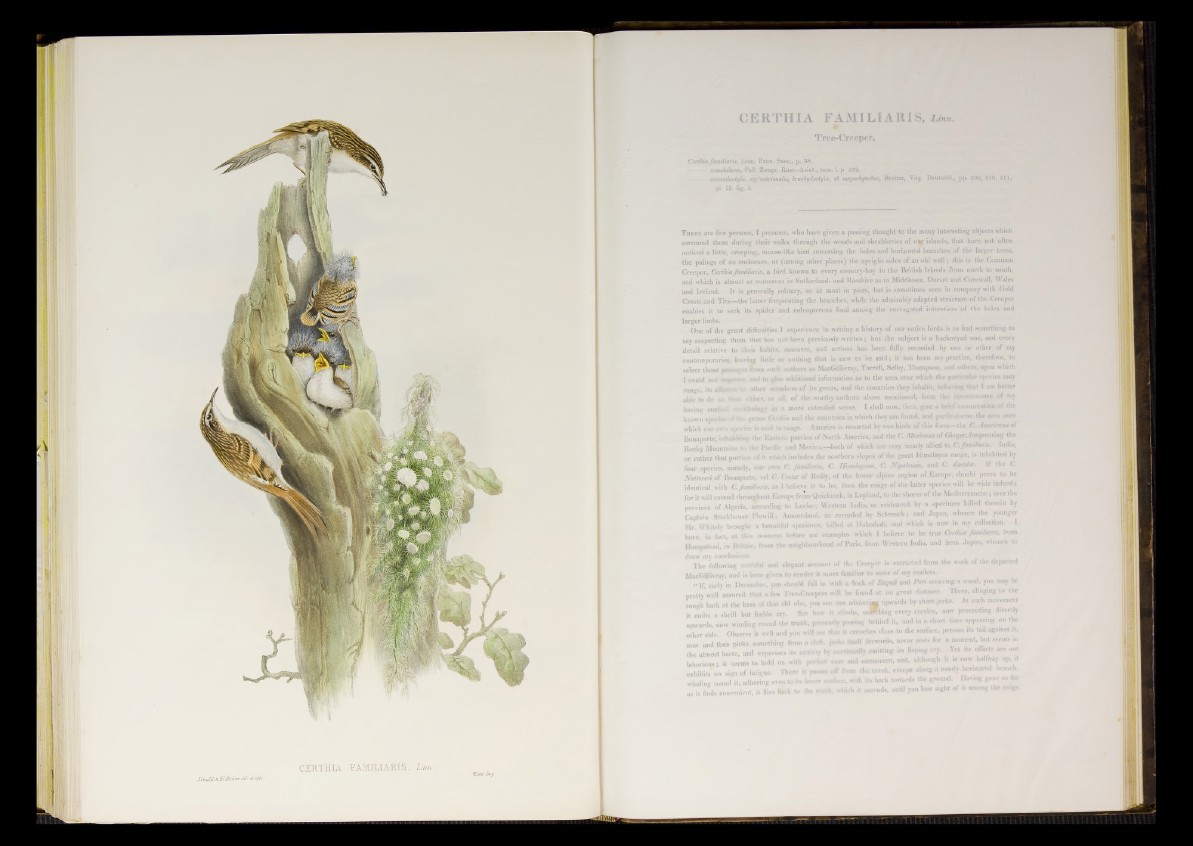
J.Cmdêb kRCRichltr. dtb'Oihlh\
C E R T H IA ÏAMBLIA.RXS, Linn
Walter. Imp
CERTHIA FAMILIARISj L in n .
Tree-Creeper.
Certfiia familiaris, Linp. Faun. Suec., p. 38.
acandulaca, Fall Zoogr. Ross.-Asiàt., torn. i. p 432.
— . ■-■crodaciyht. stf'entrionalis, brachydaclyla, çt megarhynchos, B rehm , Vog. Deutschl., jpp. 208, 210, 211,
pî. 16. fig. 5.
T h e b e are few persons, I presume, who have given a passing thought to the many interesting objects which
surround them during their walks through the woods and shrubberies of our islands, that have not often
noticed a little, creeping, mouse-like bird traversing the boles and horizontal branches of the larger trees,
the palings of an enclosure, o r (among other places) the upright sides of an old wall; this is the Common
Creeper, Certhia familiaris, a bird known to every country-boy in the British Islands from north to south,
and which is almost as numerous in Sutherland- and Rosshire as in Middlesex, Dorset and Cornwall, Wales
and Ireland. I t is generally solitary, or at most in pairs, but is sometimes seen in company with Gold
Crests and Tits—the latter frequenting the branches, while the admirably adapted structure of the Creeper
enables it to seek its spider and coleopterous food among the corrugated interstices of the boles and
larger limbs.
One of the great difficulties I experience in writing a history of our native birds is to find something to
say respecting them that has not been previously written; but the subject is a hackneyed one, and every
detail relative to their habits, manners, and actions has been fully recorded by one or other o f my
contemporaries, leaving little or nothing that is new to be said ; it has been my practice, therefore, to
select those passages from such authors as MacGillivray, Yarrell, Selby, Thompson, a n d others, u p o n which
I could not improve, and to give additional information as to the area over which the p a r tic u la r species may
range, its aUkiM-« to other members of its genus, and the countries they inhabit, believing th a t I am better
able to do so tbrm cither, or all, o f the worthy authors above mentioned, from the c ir c um s ta n c e m my
having studied .hoJogy in a more extended sense. I shall now, then, give a b r ie f enumeration o f the
known specie» o f tto genus Certhia and the countries in which they are found, and particularize the a r e a over
which our own species is said to range. America is tenanted by two birds of this form the C. Americana of
Bonaparte, inhabiting the Eastern portion of North America, and the C. Mexicam of Gloger, frequenting the
Rocky Mountains to the Pacific and Mexico,—both of which are very nearly allied to C. familiaris. India,
p r rather that portion of it which includes the southern slopes of the great Himalayan range, is inhabited by
four species, namely, our own C. familiaris, C. Himalayana, C. Nipalensis, and C. discolor. If the C.
Nattereri of Bonaparte, vel C. Casta of Bailly, of the lower alpine region of Europe, should prove to be
identical with C. familiaris, as I believe it to be, then the range of the latter species will be wide indeed;
for it will extend throughout Europe from Quickiock, in Lapland, to the shores of the Mediterranean ; over the
province of Algeria, according to Loche; Western India, as evidenced by a specimen killed therein by
Captain Stackhouse Pinwill; Amoor-land, as recorded by Schrenck; and Japan, whence the younger
Mr. Whitely brought a beautiful specimen, killed at Hakodadi, and which is now in my collection. I
have, in fact, at this moment before me examples which I believe to be true Certhia familiares, from
Hampstead, in Britain, from the neighbourhood of Paris, from Western India, and from Japan, whence to
draw my conclusions-.
The following tmtbfhl and elegant account of the Creep* is extracted from the work of the departed
MacGillivray, and is here given to render it more familiar to some of my readers.
“ I f early in December, yon should fall in with a dock o f RegvK and P m scouring a wood, you may be
pretty'well assured that a few Tree-Creepers will be fonnd a t no great distance. There, clinging to the
rough hark at the base of that old elm, you see one advancing upwards by short jerks. At each movement
it emits a shrill but feeble cry. See how it climbs, searching every crevice, now proceeding directly
upwards, now winding round the trunk, presently passing behmd it, and in a short time appearing on the
other side. Observe it well and yon will see that it crouches close to the surface, presses its tail against it,
now and then picks something from a cleft, ju ris itself forwards, never rest, for a moment, but seems ,n
the utmost haste, and expresses its anxiety by contimiaUy emitting its lisping cry. Yet its efforts are not
laborious 5 it seems to hold on with perfect e a « and unconcern, and, although it is now halfway op, it
exhibits' no sign of fatigue. There it passe, off from the trank, creeps along a nearly horizontal branch,
winding round it, adhering even to it, lower .nrf.ee, will, Its hack toward, the ground. Having gone as far
as it finds convenient, it flies back to the m i . which it ascends, until yon lose sight of it among the twig,